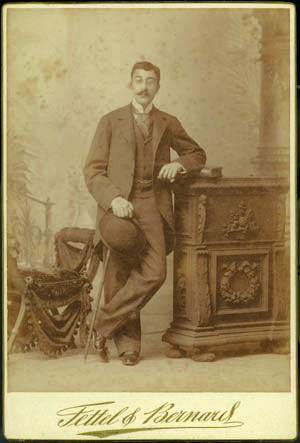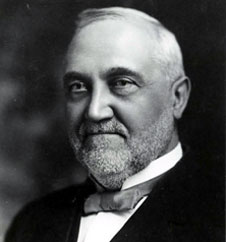|
 |
Constantine Cavafy, with cane and hat in hand
Photograph dated 1896
Alexandria, Egypt
Cavafy Archive, S.N.H.
|
Constantine P. Cavafy (1863–1933), the eminent Greek Alexandrian poet, would no doubt have found himself at home in the Kelsey Museum. He often drew inspiration from the ancient world, particularly the classical and late antique spheres that are so well represented by the Kelsey collections. What better place, then, to encounter Cavafy than next to the objects that might have stirred his fertile imagination, objects he, in turn, enriched with his poetry?
Cavafy, who was once described by the renowned writer E. M. Forster as “standing at a slight angle to the universe,” is internationally celebrated as one of the most original poets of the twentieth century. A Greek from Alexandria, Cavafy lived most of his life in Egypt amid the ruins of several empires, in the dust of Cleopatra, Antony, and Alexander. The spirit of Alexandria’s great, lost library inspired his lifelong learning. Consumed by a curiosity about things past, Cavafy set his poems, written in elegant, economical Greek, in the great empires of the eastern Mediterranean, from the Hellenistic to the modern period. He charged his words with irony, eroticism, longing, and deep reflections on history’s changing fortunes.
Cavafy’s presence at the Kelsey invites the visitor to contemplate a dialogue between modern poetry and archaeology. Through Cavafy’s eyes, the viewer can reconsider the museum’s collection of mummy masks, Fayum portraits, funerary steles, jewelry, textiles, coins, and objects from everyday life. Visitors are also invited to learn about Cavafy’s life, read his manuscripts in the original Greek or in translation, view pictures of his family and of Alexandria, and discover the relations between his poetry and artifacts in all the Kelsey galleries. The exhibit continues at two other venues: David Hockney’s Cavafy-inspired etchings are on display at the University of Michigan Museum of Art (Hidden Things), and Cavafy’s most valuable manuscript and early publications are exhibited at the Hatcher Graduate Library (The Poet in the Library).
 |
|
Francis W. Kelsey
Photograph, 1920s
Kelsey Museum neg. 5.7963
|
Finally, consider the connections between Cavafy and Francis W. Kelsey (1858–1927), who established the museum collection in 1893. Although Cavafy came from Egypt, Kelsey from New York, they were near contemporaries. Both were interested in history’s neglected periods. Cavafy used late antiquity as a backdrop for human drama; Kelsey collected its remnants. Cavafy was an impoverished member of a diminishing community of Greek Orthodox Christians in Egypt; Kelsey, a Protestant from the US, with its growing wealth and power. With missionary determination, Kelsey and his photographer, George Swain, photographed and collected artifacts and manuscripts from Christian minorities in the Near East. Some of these photographs are included in this exhibition. While Cavafy never found himself on the other side of that lens, he might have. Here is an exhibition that brings the Kelsey collection into focus from Cavafy’s rich, “slightly angled” point of view.
|
|
|